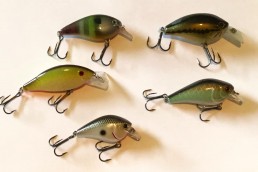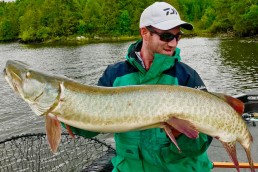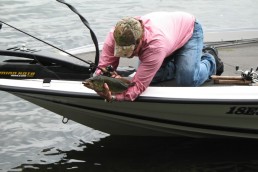SHARE THIS POST
Square-billed crankbaits are chunk-and-wind-simple lures that can be handed to a first-time angler on a spinning combo—heck, a push-button spincasting outfit—with the advice to “cast as far as you can” and then “wind as fast as you can.” If the lure doesn’t bog down in weeds or bottom detritus, and if bass or pike are around, the newbie likely will hook up.
But this is also a lure that can be fished with a lot of skill and a careful feel during the retrieve. Experienced anglers can steer it into stumps or boulders where the lure has proven itself to be surprisingly snagless, with lots of hits coming when the lure ricochets off a stump or stone—the crash and deflection triggers fish.
Another square-bill tactic is reeling it fast over the tops of weeds or through weeds that aren’t so wadded together that a crankbait doesn’t stand a chance. With enough practice, you can develop the feel and reactions to highball a square-bill into a clump of weeds and stop abruptly before you get weeds on the hooks. Then, you’ll be able to give a bit of slack to let the lure float so it actually floats up and backs out of the mess, clean as a whistle. Change your rod angle to get it around whatever obstruction was there and reengage the “afterburners.” Being able to back out of weeds is a huge advantage square-billed cranks have over lipless rattlers, which can sink.
Other times you can cast a square-bill—one you choose because it will dive close to the tops of weeds or along an outside edge—and burn it back with the rod pointed right at the lure. Any resistance, or if the angler snaps the rod upward, you can either blast through the weeds or drive hooks home into the maw of the bass.
Yours truly is kind of new and old to square-bills, and to be honest, they just entered my arsenal again this year after a long absence. Fishing buddy Joe Colegrove caught some dandies on them last year, leading me to occasionally put down the jig-and-finesse rods and get back to burning.
I had some success in a kayak tournament the first time I threw a Storm Arashi 3 in the Baby Bass pattern. In fact, it didn’t take five casts before I caught a nice 16-inch fish. This was in early April and I was on a fairly unfamiliar lake, but the Navionics chip in my depth finder showed me that I was on a massive flat that ran about 4 feet deep, sometimes a little shallower, and sometimes a little deeper. Since the water had some stain to it and we were on the north side where it warms up quicker than the rest of the lake, I reasoned bass ought to be around in a pre-spawn pattern, just cruising and feeding among the scattered weeds.
It was a good guess.
Although the first was the only bass I caught on the Arashi, I lost another good one on it in the same area near the end of the day. Water temps were in the high 40s, which shows you a square-bill can provoke reaction strikes from bass, even when they are chilly and otherwise sluggish.
Are you enjoying this post?
You can be among the first to get the latest info on where to go, what to use and how to use it!
The next weekend, I decided to add to my meager square-billed collection and bought a pair of matching Strike King KVD square-bills in a colorful Bluegill pattern at The Bait Shop in Waterford, Mich. I was one of the kayakers on Pontiac Lake, where 15 kayaks would take on 15 bass boats in a fiasco called “The War On the Water.” The area near the launch ramp was a similar large flat like the one the weekend before at Kent Lake, and water clarity was similar, so I tied on one of my new KVD 1.5s and immediately caught a small bass on it.
After that initial success, the bait cooled off drastically and I would not catch another fish on it until afternoon when Mother Nature slammed us with terrific winds. Tossing the little Ned Rig was nearly impossible, so I committed myself to the bluegill-colored square-bill and ended up caching six bass and six or seven pike on it. The technique was brain-dead simple: Just hurl the bait as far as you can downwind with the kayak anchored as well as possible, and then wind it back, reeling fast. But ready to let it back out of the weeds when it gets ensnared in a clump, or just give it the quick snap when resistance occurs.
A scan online reveals that square-billed cranks first appeared in the 1960s with Fred Young’s hand-carved Big-Os. Made of wood, they were fragile—whack a dock with one and it was often toast. The first plastic models were good, but overall, they had the reputation that they just didn’t catch fish like the wood models could.
By the 1990s, that was starting to change, and one of the plastic lures that was superb was the Luhr-Jensen Speed Trap. It became this writer’s favorite lure for covering water on 6-foot flats and places where it cold go down and nip weeds. As the name implies, the Speed Trap was designed to burn.
Tom Seward, then an employee of Oregon-based Luhr-Jensen, designed the Speed Trap. I met him at a national outdoor writers get-together where he gave me a few to try. Tom was a true lure artist and one of the most interesting fish minds I’ve ever encountered. He designed the Speed Trap to be reeled as fast as humanly possible, without it missing a beat. The lures he gave me came packaged with a rounded snap, which Tom said allowed the lure to swing more freely and stay in tune—they still come packaged with a snap today. A free thinker, Tom spurned the taboo against throwing crankbaits on spinning gear, saying that spinning reels simply brought in lures faster than the baitcasters available back then could.
Square-bills are a pretty cool lure type. Obviously, they have some limitations in that they don’t dive real deep, but most bass waters have some areas with water shallow enough and just the right amount of weeds where they can truly shine.
If you have fished square-bills much, you know how effective they are. If you are new to these high-speed wigglers, add some to the arsenal and get ready to burn, baby burn.
MWO
SHARE THIS POST
Did you enjoy this post?
You can be among the first to get the latest info on where to go, what to use and how to use it!
Dave Mull
Dave Mull of Paw Paw, Mich. has spent his career communicating the outdoors experience and runs Inner Viking Media. He enjoys kayak fishing for anything that swims in the lakes and rivers of the Midwest and beyond, and even uses his MirroCraft, from time to time. Available for seminars.



